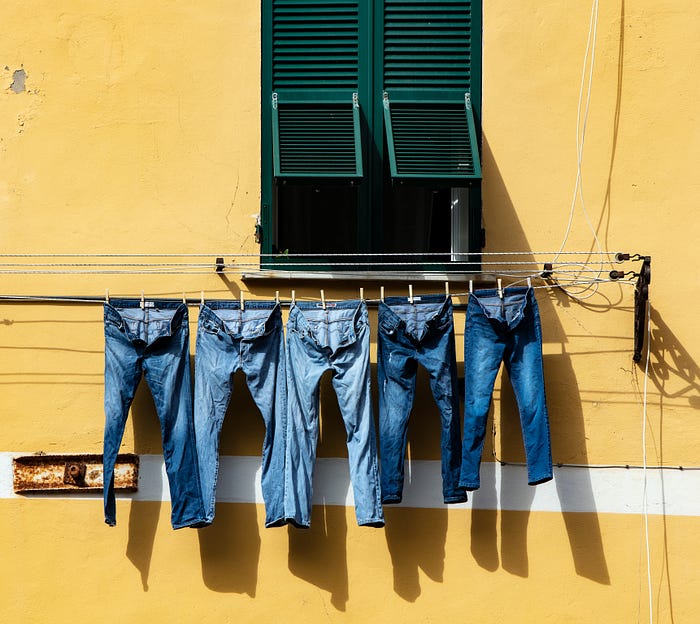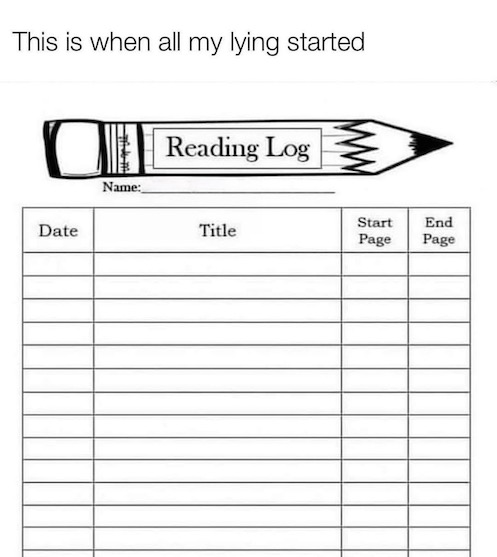My Flameless Pants
Telling the truth in a world that rewards fiery pants

—
A friend recently shared an adorable little meme on Instagram. It was really meant to be targeted to the GenX crowd and to elicit a little laugh.
To be honest, the meme made me a little bit anxious. I got the joke, but maybe I didn’t really get it because that meme wasn’t true in my experience.
Here it is:

Meme found all over the place on the web, just Google it
—
My husband is my gauge of what is normal as opposed to whatever weirdness is rattling around in my head. He looked at the meme and he got the joke. A laugh in the form of a puff of air escaped his nose.
“But, that wasn’t me! Was that a thing? Did people really do that?” I was apoplectic at this point.
He told me that he personally did not cheat on his reading log. He didn’t have to because he was then and is now a voracious reader. But he knew plenty of classmates who were not completely honest when they turned in their reading logs.
“People won prizes for how many books they read!” I countered. “How could someone cheat about how many books they read?”
He shrugged in that familiar way he does, which was his way of saying, “I don’t condone it, but it happens.”
Lying is learned
One sunny summer afternoon, after my family had gone swimming at our local public swimming pool, we were back home being lazy on a hot day. My mom had left the front door open to catch what little bit of breeze could be found.
My brother and sister were in the back of the house in their rooms. My mom was taking a shower. On the couch in the front room, I was reading a book. (See! Actually reading.)
An adult came to the door, peered into the house, and rang the doorbell. He saw me sitting there. My parents were very strict and taught all of us kids early on to respect our elders, so I could hardly ignore him.
He asked if my mother was home, and I replied truthfully that she was in the shower. He recommended that it was best to go get her because he needed to speak with her right away. Dutifully, I went to the bathroom where my mom was showering and informed her that someone was at the door and needed to talk to her right away.
She got out, threw on some clothes, and rushed to the door. He was a door-to-door salesman. What was so important was his need to separate my mom from her money. She sent him away with a scolding and slammed the door behind him.
Then she sat me down and began to talk about telling the truth and the times when it is okay to lie. My sister wandered out to see what was all the commotion and she joined in.
They tried to explain that fine line between how important it is to tell the truth but also it’s okay to lie. They really tried to help me understand.
For years my mom loved to tell that story to friends and family. The one about how her youngest kid just couldn’t lie.
Isn’t that a good thing?
Lying to get hired for a really good job
In college I took several classes under my Finance major about investments. The business school was fortunate enough to have one professor who had spent time on the New York Stock Exchange and another who had traded futures in Chicago. They told amazing stories of the investment world and I loved it. It seemed like the place to be.
Nearing graduation, I began applying at investment firms. As a standard part of the recruitment process, applicants would be asked to sit at a computer terminal and answer a long exam with questions like, “If you were not meeting your monthly goal, would you sell to your family? Your friends? Would you sell to your grandma to make your numbers?”
The truthful responses to the questions were no, no and no. I would not shake down my family to make monthly sales goals. It seemed so wrong. Clearly this was an ethics question, right?
The hiring manager laughed when the results of my exam were placed on the desk in front of him. He looked me in the eye and told me it was the lowest score he had ever seen.
Then he said that this just wasn’t going to be the right job for me.
Honesty had cost me a lucrative career. Perhaps that was for the best. I ended up going back to graduate school, instead.
A little more maturity was in order before trying the job market again.
Negotiation and the art of lying
After graduation and working for a year as an unhappy financial analyst, the phone rang with an offer of a job to become a procurement professional.
With zero background in procurement, they offered to train me in the ways of how to be a buyer. It was a desirable employer and an excellent job offer, so I made the move.
Being a quick learner helped me come up to speed fast. Growing into the role I was soon confronted with learning the art of negotiation. The subtle ways of asking for what the company needed and occasionally bending the truth to get there.
Later, my career expanded to what is now one of the largest computer companies in the world. A company that is also well known for their ability to negotiate.
Supporting a robust team of Information Technology professionals, I learned how to negotiate the extensive language of software licensing agreements from some of the most well known and successful negotiators in the world.
Oddly enough, while at the negotiating table I was able to fib, bluff, and occasionally lie my ass off to get what was necessary to close the deal. For some reason, under the context of work, it was fine.
There was no mercy and no remorse for the clueless salespeople on the other side of the table. Soon, I was recognized and well rewarded for my negotiation skills.
Then at the end of the day I would walk out the back door and go back into a personal life where I could not tell a lie if my life depended on it.
A very strange dichotomy that somehow still makes sense.
The problem is that you have to remember what lies have been told
When talking about this with friends, the main reason cited for why I can’t lie is that, honestly, my memory just isn’t that good. Once the lying starts you have to keep lying and then remember all of the lies that have already been told.
Ugh, no one has time for that. Easier to tell the truth and not have to keep track of it all.
And the research agrees:
That said, when it comes to lying during a negotiation, it helps to take meticulous notes to keep track of what was said so I don’t trip up. Also, it’s best to stay away from saying truly whopper sized lies. The exaggerations that start with a kernel of truth are a lot easier to remember and say without remorse. Much cleaner on the ol’ conscience.
For example, there was a certain dollar threshold where the Chief Financial Officer (CFO) had to approve the deal. The CFO was usually quick to provide approval after hearing the business case. At the negotiation table, I would say, “Well look, if you can’t get the price down, this deal has to go all the way to the CFO’s officefor approval. And you can imagine what that’s like.”
No lies told, but a little creative exaggeration using tone of voice and body language. Any salesperson knew that the more people who have to review and approve a deal, the longer the deal will take. Also more approvers increases the chance for a no.
Magically the numbers would come back just under the approval threshold I had mentioned, making it easier for everyone. Funny that.
With time I also found a really interesting weapon to use in the art of negotiation. Honesty.
When used the right way, dropping the pretense and being bald faced honest can also get enormous results.
Quite a few salespeople have even expressed their thanks for my being straightforward and helping them to understand how to close the sale. Honesty might just be my best weapon.
Which is not the same for all of the members of the negotiation teams back then. More than once I sat there quietly while executive members of the leadership team told some really profound untruths during the course of a negotiation.
By keeping a straight face it could be said that I was also lying by being silent.
Getting smarter with age
Today, all these years later, I still don’t like to lie. It feels icky, but I have gotten smarter about understanding in what circumstances a well-told bluff can help.
Recently the doorbell rang and usually I would not open the door at home if a visitor wasn’t expected. But there I was in a room with the window open to let in a cool breeze. The person at the door could see me in there.
“Helloooo,” they called out.
Feeling cranky, I opened the door. The person on my front porch went through a brief sales pitch and wanted to know which internet provider we were using. Their company’s solution, they said with confidence, would be much better.
Pulling out a clipboard they detailed which internet company each of the neighbors were using, house number by house number. They confirmed that they just needed to know which service this house was currently on.
Well, after working in the procurement world for far too long, I have seen most of the tricks that the sales profession has to offer. This person at my door had no idea whose doorbell they rang.
You see, this salesperson had just tipped their hand. They needed to know who my internet provider was just a little too much. Perhaps they were told to come back with that information for the whole neighborhood.
Slipping immediately into negotiation mode, the mask went on. This was no longer personal, this was business.
“We’re all good here, not looking for a new service, thanks for stopping by.”
“But wait, just tell me what service you are on.” A ballpoint pen hovered over a clipboard anxiously awaiting my response. It seemed so awfully important.
But it just didn’t feel like information I needed to share.
“Thanks again, okay, bye now!” I said, and quickly closed the door.
Through the shade over the window in my front door I could see the salesperson stand there for three long beats, then their shoulders sag, and finally they turned and left.
You see? I’m so much smarter when it comes to handling door-to-door salespeople.
And I didn’t even need to lie.
—
This post was originally published on Medium and more of my work can be found over there @karenfayeth.
 Image by
Image by 


